Exploring Sapphire Color Value: What Matters Most?
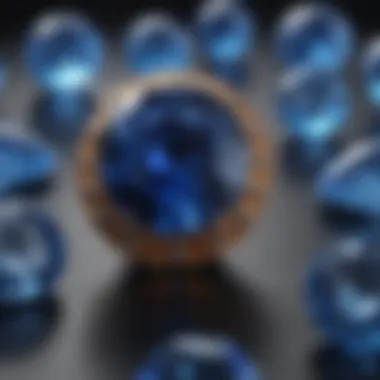
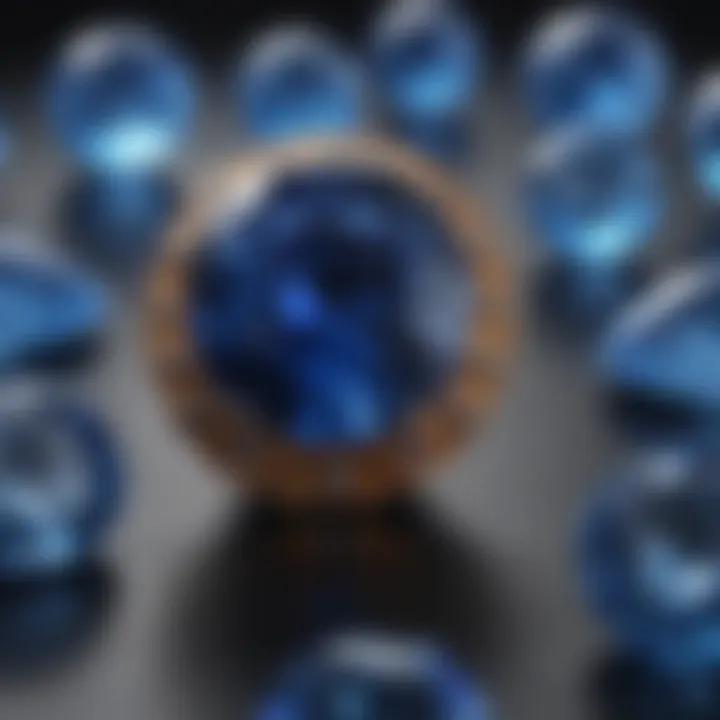
Intro
Sapphires have captivated humans for centuries, not just for their visual beauty but for their deep historical and cultural significance. In the realm of gemstones, sapphires represent both luxury and status. However, not all sapphires are created equal, and their worth can significantly vary based on color and other factors. This article will examine the intricate value spectrum of sapphires, with a focus on the most prized hues, their historical context, and the criteria that influence their evaluation.
Gemstone Overview
Definition of Gemstones
Gemstones are typically defined as precious or semi-precious minerals that are cut, polished, and used in jewelry and adornments. They are valued for their rarity, beauty, and durability. Among these, sapphires, belonging to the corundum mineral family, are particularly esteemed, but their worth is not solely determined by their appearance. A closer investigation reveals that color plays a paramount role in defining the gem's market value.
Classification of Gemstones
Gemstones can be classified into various categories based on their physical properties, origin, and cultural significance. Sapphires fall primarily under the category of gemstones, which also includes emeralds, rubies, and diamonds. Within gems, we can observe further classifications:
- Natural Sapphires: Formed naturally over millions of years.
- Synthetic Sapphires: Lab-created and often indistinguishable from their natural counterparts.
- Treated Sapphires: Natural stones that undergo treatments to enhance color or clarity.
The differentiation among these types of sapphires dramatically influences their valuation in the market.
Historical Significance
Origins of Gemstone Use
Gemstones have a rich history that dates back thousands of years. Sapphires have been treasured since at least 800 BC, as their vibrant colors have found their way into jewelry and crowns of royalty across different cultures. Often, these gemstones were thought to hold protective qualities, giving strength to the wearer. The deep blue sapphires, in particular, were associated with divine favor and royal lineage.
Cultural Insights: Gemstones in Ancient Civilizations
Across ancient civilizations, sapphires held various significant meanings. In Persian culture, they were believed to be indicators of heaven, while the ancient Greeks associated them with Apollo, the god of wisdom. The Romans too revered sapphires, often engraving them with images of deities, symbolizing power and divine favor.
"Gemstones, especially sapphires, have been intricately woven into the cultural fabric of societies, indicating status and belief through centuries."
This historical context provides vital insights into why the color variants of sapphires continue to hold emotional and monetary value, shaping modern perspectives on these stunning gems.
Intro to Sapphire Value
Understanding the value of sapphires extends far beyond their shimmering facade. The nuanced appreciation of sapphires is intricately linked to various factors, with color occupying a pivotal role.
When discussing sapphire valuation, one must consider how color directly influences not only the gemstone's beauty but also its market desirability. Different hues of sapphire evoke unique responses from collectors and consumers alike. In this context, a deep blue sapphire often commands higher prices compared to lighter shades, due to its historical prominence and cultural associations.
Moreover, sapphires are graded based on qualitative criteria, and color remains central to this evaluation process. Grading systems take into account hue, saturation, and tone. These attributes help determine the overall quality of a sapphire, ultimately affecting its market value.
Through this exploration of sapphire value, we aim to dissect these elements further, shedding light on why certain colors are regarded as more desirable than others. Identifying the reasons behind sapphire color valuation can benefit both enthusiasts and potential investors. An informed understanding of this topic can lead to better decision-making in acquisitions and collections.
The Importance of Color in Sapphire Valuation
Color is arguably the most significant factor when it comes to valuing sapphires. Not only does it contribute to aesthetic appeal, but it also invokes emotional connections in buyers.
- Market Trends: Over time, specific colors have fallen in and out of favor, affecting their valuation in the market. For example, blue sapphires have maintained a classic status, while pink and yellow sapphires have recently surged in popularity.
- Cultural Associations: Different cultures place varying significance on sapphire colors, which can influence consumer preferences. For instance, blue sapphires are often linked to nobility and spiritual meanings in many traditions.
- Subjectivity in Perception: Individual inquiry shapes how one perceives color. A collector's personal preference or cultural background can alter their perception of value.
- Availability: Rarity also correlates with color; some hues are naturally scarce, leading to higher prices for those stones.
The essence of sapphire valuation lies in a simple yet profound fact: its color holds intrinsic power over market possibilities and consumer attraction. Understanding this is vital for anyone engaging in the sapphire market.
Understanding Sapphire Color
Understanding the color of sapphire is essential for appreciating its value and desirability. In the gemstone market, color plays a pivotal role in determining price and preference among collectors. Different colors of sapphires are not just a reflection of beauty; they embody rarity, cultural significance, and investment potential. The color itself influences how sapphires are graded and perceived, which is critical for anyone looking to invest in or appreciate these gemstones.
Sapphire Color Spectrum
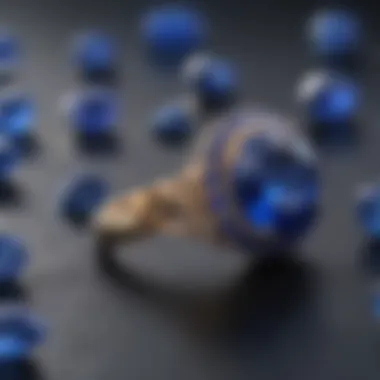
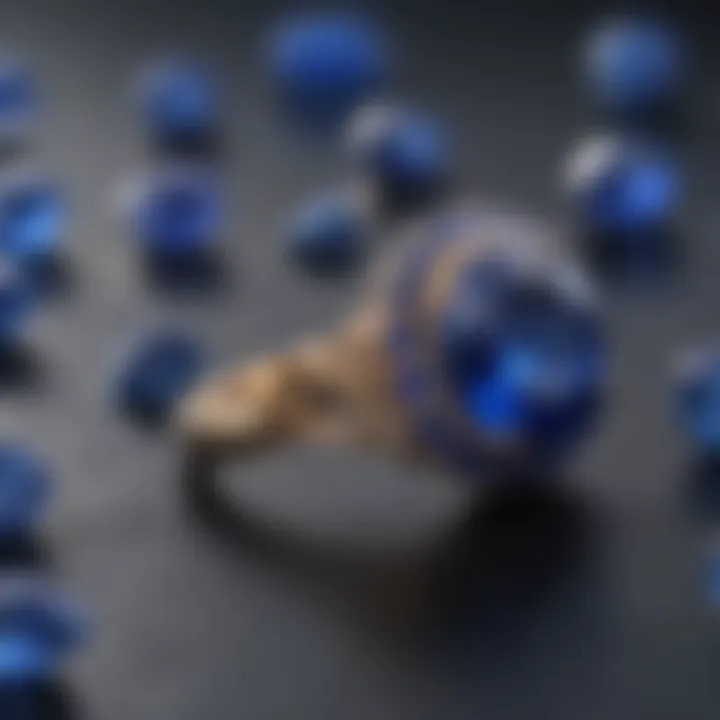
Sapphire comes in a wide array of colors. Traditional blue sapphires are the most recognized, but there are also pink, yellow, green, and even colorless variants. Each color can represent different meanings, cultural beliefs, and preferences, thus influencing their market demand.
The sapphire color spectrum includes:
- Blue: The most sought-after and recognized hue.
- Pink: Gaining popularity, especially among younger generations.
- Yellow: Often overlooked but holds its significance.
- Green: Seen as unique due to its rarity in the market.
- Padparadscha: An exotic orange-pink blend, prized for its uniqueness.
Understanding this rich spectrum allows buyers and enthusiasts to navigate the complex market with more clarity. Each color variant has its own subcategories and grading standards, which also need to be considered.
Key Factors Influencing Sapphire Color
Sapphire color is assessed based on three primary factors: hue, saturation, and tone. Each plays a significant role in the overall appearance and value of the stone.
Hue
Hue refers to the dominant color of the sapphire. Specific hues can dictate their desirability in the marketplace. For instance, the richness of a blue sapphire can directly affect its market value. The vibrancy of the hue is a key characteristic, as deeper, more vivid hues tend to be more desirable.
One advantage of a well-defined hue is that it can enhance the stone's appeal, making it a favorite among collectors and investors. However, hues that are too dark or too light can detract from the stone's value, creating a balance that must be considered when evaluating sapphires.
Saturation
Saturation measures the intensity of the color. A sapphire with high saturation will appear more vibrant and engaging, which usually leads to higher valuation. The key characteristic of saturation is that it indicates how pure the color is.
Higher saturation levels often equate to more competitive prices in the market. However, excessive saturation can sometimes lead to a less desirable aesthetic, especially for certain colors like yellow and pink, where the color might appear too flashy or unnatural.
Tone
Tone refers to the lightness or darkness of the sapphire. This determining factor enhances how the hue and saturation are perceived. A well-balanced tone can help achieve an overall pleasing appearance. If a sapphire is too dark, its beauty might be lost in the depth of color, while a very light tone can sometimes appear washed out.
Finding a balance in tone is vital. It can either emphasize or undermine the overall visual appeal of a sapphire, significantly impacting its value. Collectors tend to favor those with a medium tone, where the depth of color is rich yet still vibrant.
"Understanding the nuances of sapphire color is crucial for any serious collector or investor. It impacts not just the aesthetic of the gemstone, but its market value as well."
Most Valuable Sapphire Colors
Understanding the most valuable sapphire colors is essential in evaluating gemstones. Color significantly influences market price, desirability, and the general perception of a sapphire's worth. Various hues carry different cultural meanings and historical contexts, adding layers to their valuation.
Blue Sapphire: The Classic Value
Historical Context
Blue sapphire has a long-standing reputation as the most classic and sought-after color in the gemstone market. Its rich history dates back to ancient civilizations where it was associated with royalty and divinity. The deep blue hue has often been linked to wisdom and noble aspiration. This historical significance contributes to its popularity and solidifies its status as a valuable gemstone choice. Additionally, the unique feature of blue sapphires is the presence of trace elements like iron and titanium, which enhance their color and brilliance. However, sourcing high-quality blue sapphires can be challenging, leading to price fluctuations in the market.
Current Market Trends
In the current market, blue sapphires remain a top choice among collectors and investors alike. The consistent demand, coupled with limited supply from key mines, creates upward pressure on prices. Another key characteristic is the rise of Thailand and Kashmir as notable sources of premium blue sapphires. Moreover, untreated or natural stones often command a higher price. However, market shifts can occur based on consumer preferences, which sometimes lean towards more unique colors.
Padparadscha Sapphire: Rarity and Demand
Characteristics of Padparadscha
Padparadscha sapphires are distinctive for their unique blend of pink and orange hues. This rarity not only makes them visually striking but significantly contributes to their demand in the market. With unique color characteristics that include vivid hues and excellent saturation, they stand out among sapphires. However, their rarity also means that they can come with a high price tag, making them a potentially valuable investment.
Market Insights
Market insights reveal a growing trend favoring padparadscha sapphires, particularly among collectors seeking to diversify their portfolios. Their limited supply from Sri Lanka enhances their desirability. Buyers are increasingly aware of their significance in high-end jewelry, pushing prices higher as the interest expands. A unique feature here is the growing awareness and appreciation for ethically sourced padparadscha sapphires, which offers an additional layer of value.


Pink Sapphire: Emerging Preferences
Popularity Dynamics
Pink sapphires have emerged as a trendy choice in recent years. Their gentle color range appeals to a wide audience looking for something different from traditional blue sapphires. This shift in preference highlights a broader acceptance of diverse sapphire colors, allowing for new conversations surrounding value. Additionally, the unique characteristic of pink sapphires is their ability to pair well with various metals, which boosts their popularity further.
Comparative Value
While blue sapphires still dominate in terms of overall value, pink sapphires have started to carve out their niche. Their market value can vary significantly based on color intensity and clarity. Reports indicate that certain shades of pink sapphires may soon rival traditional blue sapphires in valuation. However, inherent market dynamics mean that obtaining high-quality pink sapphires at a reasonable price can be challenging.
Yellow Sapphire: Significance and Pricing
Yellow sapphires hold unique significance in various cultures, often associated with optimism and prosperity. Their vibrant color can range from pale yellow to rich gold. This color provides unique market advantages as its pricing often remains more accessible compared to other colors, making it appealing to a broader audience. However, they may not receive the same level of market attention, which can limit price appreciation.
Green Sapphire: Assessing Worth
Green sapphires are notable for their rich, earthy tones. While they offer beauty and rarity, they often reside in the shadow of more popular colors. This allows savvy buyers an opportunity to explore greener options without spending on traditional high-end sapphires. Green sapphires' worth can vary widely based on clarity and the shade of green, often providing high-caliber stones at lower prices.
Other Color Variants: Value Considerations
Violet Sapphire
Violet sapphires present a unique alternative for collectors. Their deep purple tones are both eye-catching and rare, leading to a specific kind of appeal within niche markets. The primary challenge is their limited recognition compared to more conventional sapphire colors. Discerning buyers often recognize their value, especially when they exhibit striking saturation.
Orange Sapphire
Orange sapphires, with their warm tones, are still relatively underappreciated. These stones offer a unique vibrance and can range widely in price based on quality. With growing interest, they may become a sought-after option among collectors looking for standout pieces. However, like violet sapphires, they still require education in the market to be fully appreciated.
Rarity and Its Impact on Sapphire Value
The concept of rarity plays a pivotal role in determining the value of sapphires. When it comes to gemstones, scarcity often translates directly to desirability. Various factors contribute to the rarity of specific sapphire colors, which in turn influences market valuations. Understanding how rarity impacts value can help collectors and enthusiasts make informed decisions in acquiring these precious stones.
Scarcity of Specific Colors
Certain colors of sapphires are considerably more scarce than others. For example, the intense blue hue of sapphires is ubiquitous and widely available. In contrast, shades like Padparadscha—characterized by a unique blend of pink and orange—are remarkably rare. The scarcity creates a situation where these colored sapphires often command higher prices due to increased demand among collectors and investors.
Notably, pink sapphires have also gained traction in the market lately, overshadowing traditional blue sapphires in some instances. Factors like demand from the fashion industry and rising popularity among consumers lead to price hikes for colors that may be rarer.
Geographic Sources of Valuable Colors
The geographic origin of sapphires plays a significant role in their value. Different countries are known for specific colors or qualities of sapphires.
Sri Lanka
Sri Lanka is renowned for its vast deposits of high-quality sapphires. The island produces a variety of colors, but the blue sapphires from this region are especially prized. This is due to their deep, rich hues and clarity. Sri Lankan sapphires often have a unique characteristic—a certain luster that makes them highly sought after. The reliance on sustainable mining practices in the region adds to its appeal as a source for gemstones.
Myanmar
Myanmar, formerly known as Burma, is another crucial source of sapphires. The country is particularly famous for its pigeon blood red rubies, but it also produces some exceptional blue sapphires. The intensity of these sapphires can be unparalleled, leading to high valuations. However, geopolitical issues have sometimes complicated trade routes and extractive practices, potentially introducing risks for buyers.
Australia
Australia is often regarded for its yellow and parti-colored sapphires. Its unique geology allows for a spectrum of hues, making Australian sapphires diverse in appearance. Over the years, the country has established itself as a sustainable source of sapphires, with mining practices that respect environmental guidelines. While they might not reach the same price points as the blue sapphires from Sri Lanka or Myanmar, Australian sapphires offer affordability without sacrificing quality.
Through understanding the rarity and geographic origins of different sapphire colors, enthusiasts can appreciate not only the aesthetic aspects but also the underlying economic principles governing the sapphire market.
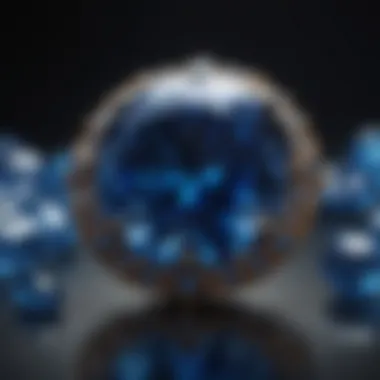
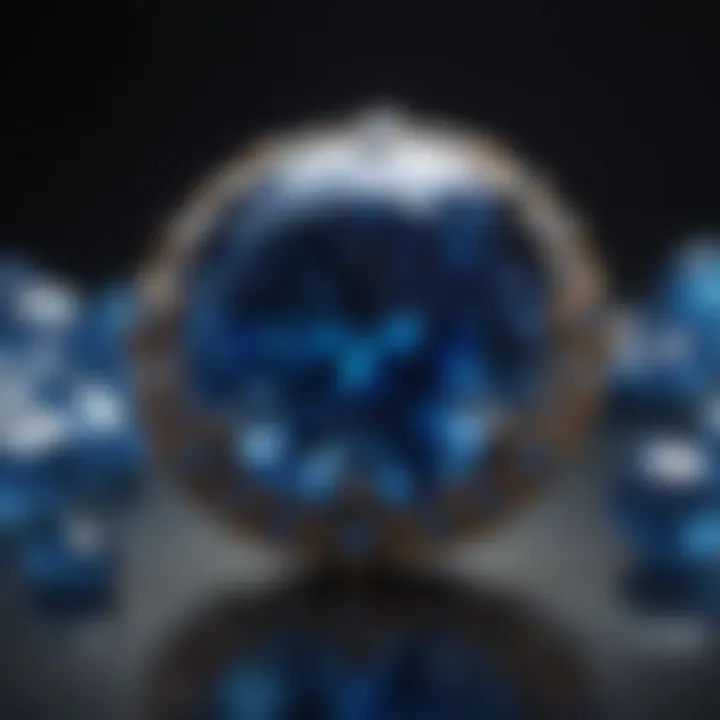
The Role of Treatments in Sapphire Valuation
Sapphire treatments play a crucial role in determining the value of these gemstones. While natural sapphires hold intrinsic beauty and worth, many sapphires undergo enhancements to improve their appearance. Understanding these treatments is essential not only for valuation but also for making informed decisions when purchasing gems. Treatments can enhance color, clarity, and overall quality, affecting both desirability and market price.
It is important for buyers, collectors, and sellers alike to be knowledgeable about these processes, as they directly influence how sapphires are perceived in the market. Additionally, consumers should consider how treatment impacts the longevity and maintenance of the gem, which can also factor into the overall value.
Common Treatment Processes
Several treatment processes are commonly used to enhance sapphires:
- Heating: This is the most prevalent treatment. Heating transforms the color of sapphires and improves their clarity. Almost all colored sapphires undergo this process to some extent.
- Diffusion: This method involves introducing foreign elements to the surface of the gemstone, altering its color. It creates vibrant hues but can be less durable than other treatments.
- Oil or Resin Filling: This process is used to fill surface-reaching fractures. This enhances transparency and overall appearance but can raise scrutiny regarding durability.
- Laser Drilling: This technique involves using lasers to create small holes that allow for the removal of inclusions. While it improves clarity, it can also hinder long-term value.
These processes often vary in effectiveness, and knowledge about them helps potential buyers understand their investment better.
Market Perception of Treated vs. Untreated
The market tends to view untreated sapphires as more valuable than their treated counterparts. The reason lies in the notion that natural gems are rare and possess a certain authenticity that enhanced stones lack.
- Perception Factors: Many collectors and investors prioritize untreated sapphires due to their perceived purity. This preference can significantly influence market dynamics.
- Value Implications: Generally, untreated sapphires can command prices significantly higher than treated ones. For example, a clean, untreated blue sapphire can be several times more valuable than a treated gem of the same size and color. This pricing reflects both rarity and quality.
"A vivid untreated sapphire embodies a natural beauty that treated stones often strive to replicate but seldom achieve."
In closing, acknowledging the role of treatments in sapphire valuation is vital for anyone involved in buying, selling, or collecting these gemstones. A clear understanding of the nuances involved can lead to better investment decisions and appreciation for these beautiful stones.
Cultural Significance of Sapphire Colors
The cultural significance of sapphire colors plays a crucial role in understanding the value spectrum of these gemstones. Different cultures around the world attach various meanings to colored sapphires, shaping their desirability, market price, and overall perception. By appreciating these cultural contexts, one gains deeper insight into why certain hues are favored or revered, especially in jewelry and ceremonial uses. This exploration sheds light on trends, legacy, and the transformative power of color within human history and psychology as it relates to sapphires.
Symbolism Across Cultures
Spiritual Meaning
Sapphire colors often resonate with spiritual significance, enhancing their appeal. Each color variation tends to be associated with distinct spiritual properties. For example, blue sapphires symbolize wisdom and protection. They are believed to promote inner peace and reflection, making them a popular choice among spiritual seekers. This aspect of spiritual meaning reflects a deep respect for tradition and the metaphysical qualities that sapphires can embody.
The key characteristic of spiritual meaning is its ability to connect individuals with broader, often unexplainable forces. Engaging with this aspect elevates the valuation purpose of sapphires beyond mere aesthetics or rarity. Some may consider this very beneficial, as it fosters a sense of connection to culture or belief systems. However, this can also be a disadvantage if potential buyers are skeptical about metaphysical properties, leading to skepticism towards the true value of these stones.
Folklore
Folklore surrounding sapphires adds another layer to the understanding of their significance. Various myths and stories throughout history celebrate the unique qualities of sapphires. In some cultures, they are seen as a protective talisman, warding off negative energies or entities. This characteristic not only enhances their appeal but solidifies their reputation as artifacts of cultural heritage.
The advantage of folk narratives lies in their ability to impart a sense of history and depth to sapphires. They connect personal experiences with shared traditions, creating an emotional bond. While engaging with these stories is enriching for enthusiasts, it can complicate the pricing and valuation due to varying perceptions of truth within folklore. Folklore, thus, serves as both a captivating narrative and a challenge in standardizing the value across different cultures.
The interplay of cultural significance through spiritual meanings and folklore greatly influences the historical value attributed to sapphires, leading to a multifaceted appreciation among collectors and enthusiasts alike.
Ending: Assessing Sapphire Value
Evaluating sapphire value encompasses numerous critical factors, with color being the most prominent. As explored in this article, the color spectrum greatly influences market prices and consumer preferences. Collectors and jewelry designers alike must understand the nuances associated with different hues. A sapphire’s color can often overshadow other elements of value, such as carat weight or clarity.
The importance of color stems from both rarity and demand. For instance, blue sapphires have a long-established prestige, but hues like padparadscha have surged recently in popularity due to their unique shade. Understanding these trends can equip buyers and sellers with the knowledge to navigate the market effectively.
Moreover, cultural significance adds another layer to the valuation equation. The meanings attached to specific colors vary around the globe, making it essential to appreciate cultural contexts when assessing a sapphire’s worth.
As discussed, treatments can affect both perceived and actual value. Buyers should consider whether a sapphire has undergone treatments that enhance its color.
In summary, assessing sapphire value is not merely about checking boxes on a grading scale. It requires a comprehensive perspective that considers color significance, market trends, cultural associations, and treatment effects. Each of these factors interconnects and influences the overall valuation of sapphires, making informed knowledge essential for stakeholders in this gemstone industry.
Final Thoughts on Color and Value
Key takeaways include:
- Rarity Matters: Colors such as padparadscha sapphires command higher prices due to their scarcity.
- Trend Awareness: Market values fluctuate based on shifting consumer preferences, requiring constant vigilance.
- Cultural Relevance: Understanding cultural significance helps foretell consumer tastes and sentiments.
- Treatment Impacts: The market often regards untreated sapphires more highly, affecting pricing structures.
In the competitive world of gemstones, thorough market knowledge allows for better purchasing decisions and investments.



